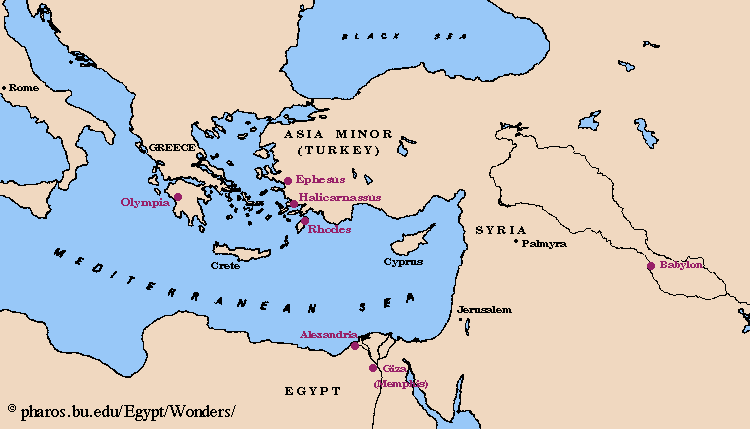
GNED 117
HISTORY OF TECHNOLOGY
Prof. Tim Richardson
Toronto, Canada

GNED 117 HISTORY OF TECHNOLOGY |
Prof. Tim Richardson Toronto, Canada |
| The
Seven Wonders of the Ancient World |
During this part of the
course, we will cover the Seven Wonders of the Ancient World.
There are several reasons why we will look at these Seven Wonders - primarily, these seven architectural constructions are the best examples of humans demonstrating an attempt to push the technology of the time to its limits - and each of these Seven Wonders contains examples of technology which we have used and refined in our modern times. Our resources for covering this material will be
|
 |
 |
 |
 |
 |
 |
 |
| Pyramids | The Hanging
Gardens of Babylon |
The Statue of Zeus at Olympia | Temple of Artemis at Ephesus | The Mausoleum at Halicarnassus | The Colossus of Rhodes | The Lighthouse at Alexandria |
| "Although most people know
that a list exists of the Seven World Wonders, only few can name them.
The list of the Seven Wonders of the Ancient World was originally compiled
around the second century BC. The first reference to the idea is found
in History
of Herodotus as long ago as the 5th century BC. Decades later, Greek historians
wrote about the greatest monuments at the time....The final list of the
Seven Wonders was compiled during the Middle
Ages. The list comprised the seven most impressive monuments of the
Ancient World, some of which barely
survived to the Middle Ages."
from http://ce.eng.usf.edu/pharos/wonders/ |

 |
The Pyramids
Still today the largest stone
structure in the world.
|
 |
The Hanging Gardens
of Babylon 600 B.C.
built without stone - used
mud bricks
|
 |
The Statue of
Zeus at Olympia
The height of the statue
was about 40' tall or equal to a modern 4 story building.
|
 |
Temple of Artemis
at Ephesus
built around 550 BC.
|
 |
The Mausoleum
at Halicarnassus
completed around 350 B.C.
|
 |
The Colossus
of Rhodes
construction took 12 years
and was finished in 282 B.C.
|
 |
The Lighthouse
at Alexandria
On the ancient island of
Pharos, which is now part of Alexandria in Egypt.
|
This page could not have
been built without the original hard work of the people in the
Dept. of Civil and Environmental
Engineering at the University of South Florida,
namely Professor
Alaa K. Ashmawy
The seven miniature pics,
and the map, on this page come from the USF page.
.